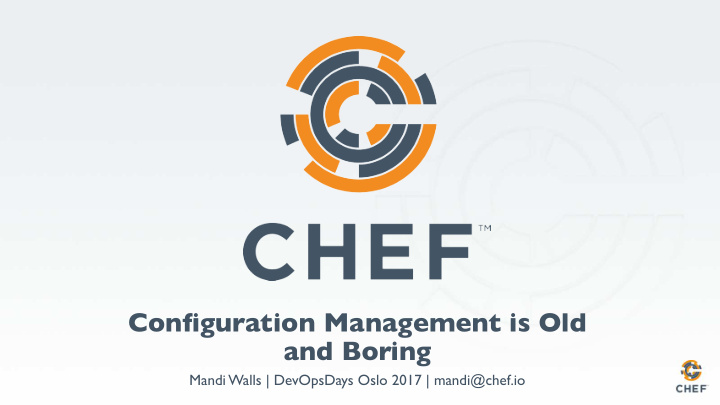



Configuration Management is Old and Boring Mandi Walls | DevOpsDays Oslo 2017 | mandi@chef.io
In the Beginning • Big expensive machines • Wizard-like Operators • Specific tools per platform
Now • Machines are cheap • Disk is cheap • Rent by the quarter hour • That future is here, but is not evenly distributed
Complexity • Technology a key component of success in many industries • “IT is a cost center” post-bust, to “Software is eating the world” 10 years later
Waterfall to Agile Era • Great for software developers • Ship it and Forget it • Stranded operators at the end of a dev cycle or sprint • Ignored the installation and running of software
Early Cloud • VMs and hardware-on-demand changed the need for Configuration Management • Web 2.0 created larger and larger environments • Beginning of the value proposition for investment in CM
Arbitrarily Defined DevOps Era • Tool proliferation across all spectrums of the Operations lifecycle • Open Source tools gain status, market • Large-scale operations and system management gains voice as a practice apart from “traditional” systems administration Distinct from the needs of HPC
Where To? • Transitioning to newer practices requires stable foundations • Building software faster means having environments that match • Infringing a bit more on build and release cycles rather than staying in Operations
Managing Lifecycle Environments • The biggest complaint we hear from teams moving towards modern practices “None of our environments match” • Production operations team doesn’t manage non-prod assets • No sharing of resources, knowledge, tools hinders good code quality
Always Shipping � Means � Always Automating
Get to Market Faster • Requires as much culture work as it does tools work • Automation of all parts of the pipeline • Releases and release installs lose complexity and angst
Reliability and Repeatability are Key • Migration away from GUI-based tools • Treating the entire environment as a code base • Risk reduction through smaller releases • Traceable histories for all changes on all platforms and environments
CM Helps You Go Fast • Build new hosts that meet your requirements • Deploy code as often as necessary • Make sure that monitoring, metrics collection, log management are in place • Minimize time-to-market with automation
Make Failing OK • New environment is cheap! • Experiment often! • Run this command, get a new environment to work on!
CM and Containers • Early lifecycle, fast development • Ecosystem still evolving Monitoring, Logs, Management, Security, etc
Everything is Faster • Old eras had longer enterprise buying cycles • 5-year plans for IT products, large investment • Even though technology executives tend to only stay in a position for a couple of years
Lots of Challenges • IT buying cycle isn’t always followed by an IT skill building cycle • Writing long-term plans with a short-term personal outlook • Doesn’t reflect modern product cycles and technology ecosystem 5 years is an eternity in “internet years”
Long Tail is Long • Software vendors sell to early adopters, mainstream adopters, and eventually to doubters • Configuration Management, for all of it’s “been around forever”- ness is still selling to mainstream adopters • The high-risk, conservative buyers, like insurance companies and utilities, still lag • Shortage of available practitioners willing to work for those organizations slows down adoption as well
We’re Here To Help • Infrastructure as Code • Continuous deployment • Testing workflows for all the changes headed for production
https://www.chef.io
Recommend
More recommend